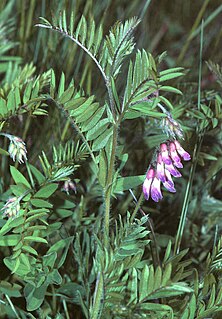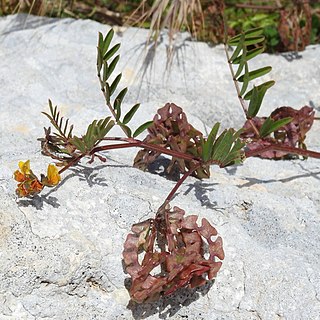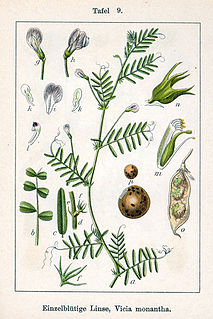
Vicia sativa, known as the common vetch, garden vetch, tare or simply vetch, is a nitrogen-fixing leguminous plant in the family Fabaceae. Although considered a weed when found growing in a cultivated grainfield, this hardy plant is often grown as a green manure, livestock fodder or rotation crop. More than 500,000 hectares/yr of Vicia sativa is grown in Australia.

Forage is a plant material eaten by grazing livestock. Historically, the term forage has meant only plants eaten by the animals directly as pasture, crop residue, or immature cereal crops, but it is also used more loosely to include similar plants cut for fodder and carried to the animals, especially as hay or silage.

Vicia is a genus of over 240 species of flowering plants that are part of the legume family (Fabaceae), and which are commonly known as vetches. Member species are native to Europe, North America, South America, Asia and Africa. Some other genera of their subfamily Faboideae also have names containing "vetch", for example the vetchlings (Lathyrus) or the milk-vetches (Astragalus). The broad bean is sometimes separated in a monotypic genus Faba; although not often used today, it is of historical importance in plant taxonomy as the namesake of the order Fabales, the Fabaceae and the Faboideae. The tribe Vicieae in which the vetches are placed is named after the genus' current name. Among the closest living relatives of vetches are the lentils (Lens) and the true peas (Pisum).

Megoura viciae is a large, green aphid in the family Aphididae native to Europe that feeds on plants in the genus Vicia. They are commonly known as vetch aphids for this reason.

Vicia bithynica known as Bithynian vetch, is a species of flowering plant in the bean family Fabaceae. It was described by Carl Linnaeus, initially as Lathyrus bithynicus but later moved to the genus Vicia (vetches). The specific name is derived from Bithynia, an ancient kingdom situated on the north coast of Anatolia, in modern day Turkey.
Astragalus boeticus is a species of annual herb in the family Fabaceae. They have a self-supporting growth form and compound, broad leaves.

Astragalus hamosus, the southern milk vetch or European milk vetch, is a plant in the family Fabaceae.
Astragalus sesameus is a species of plants in the family Fabaceae.
Coronilla scorpioides is a species of annual herb in the family Fabaceae. They have a self-supporting growth form and compound, broad leaves. Individuals can grow to 20 cm tall.

Hippocrepis biflora is a species of annual herb in the family Fabaceae. Individuals can grow to 17 cm tall.

Hippocrepis ciliata is a species of annual herb in the family Fabaceae. They have a self-supporting growth form and compound, broad leaves and dry fruit. Individuals can grow to 17 cm tall.

Hippocrepis multisiliquosa is a species of annual herb in the family Fabaceae. They have a self-supporting growth form and compound, broad leaves. Individuals can grow to 24 cm tall.

Krubera peregrina is a species of plants in the family Apiaceae. It is the only species in the genus Krubera.

Lathyrus ochrus is a species of annual herb in the family Fabaceae. They are climbers and have compound, broad leaves. Flowers are visited by Old World Swallowtail and Oxythyrea funesta.
Vicia leucantha is a species of plants in the family Fabaceae.

Vicia monantha, the barn vetch, is a species of annual herb in the family Fabaceae. They are climbers and have compound, broad leaves.
Vicia parviflora, the slender vetch, is a species of annual herb in the family Fabaceae. They are climbers and have compound, broad leaves. Individuals can grow to 0.24 m.

Pimpinella peregrina is a species of biennial herb in the family Apiaceae. They have a self-supporting growth form and simple, broad leaves. Individuals can grow to 0.72 m.
Scrophularia peregrina, the Mediterranean figwort, is a species of annual herb in the family Scrophulariaceae. They have a self-supporting growth form. Individuals can grow to 0.39 m.

Tripodion tetraphyllum is a species of annual herb in the family Fabaceae. They have a self-supporting growth form and compound, broad leaves. Individuals can grow to 0.2 m.














